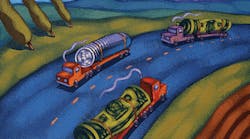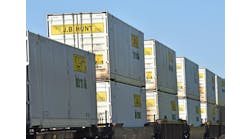Freight costs are the single largest logistics cost component in the supply chain, and controlling them should be a strategic priority for any business that has goods that need to be moved. Transportation conditions, especially the U.S. ground transportation segment, are expected to become increasingly more challenging over the next decade. Driver shortages, unpredictable fuel costs and a still-recovering economy are a few of the issues facing us all.
By scrutinizing and evaluating various aspects of your supply chain, you can identify opportunities to significantly control freight costs. Here are a few things to consider.
Improved Packaging Design
Packaging design should be reviewed on a regular basis, especially when there are changes in product types and profiles. Packaging should be engineered to properly fit the contents and eliminate wasted space, while minimizing the amount of materials required yet still providing adequate protection to the contents. Given your internal expertise and packaging complexity, there are resources that specialize in the re-design and supply of packaging materials.
In addition to reducing the cubic volume of shipments, you can also support sustainability efforts by reducing the amount of packaging materials and choosing the right type of material. Properly engineered packaging designs will also help to reduce cargo damage claims.
As packaging designs improve and density increases, design can be used to avoid the additional cost associated with dimensional weight pricing (DIM) used in the parcel and air cargo industry. The increased shipment density may create further savings on LTL shipments, if the product qualifies for a lower freight classification.
Maximizing Truckload/Container Cube or Weight Utilization
Truckload and container load shipments generally have a fixed linehaul rate based upon full utilization of the piece of equipment going from Point A to Point B. Shippers should take full advantage of this by maximizing either the volume of product fit onto the trailer/container or the allowable weight of product loaded onto the trailer/container. Even when building multi-stop truckloads, shippers should always strive to fill the cubic capacity or weight capacity of the equipment.
While this may not always be possible due to business rules or other factors, it does present an opportunity that can make a meaningful impact. Simply increasing the average trailer cube utilization from 60% to 80% not only represents a 33% improvement in cube utilization, but also equates to a 25% cost reduction. This equates to needing three trailers/containers for every four that were previously required. This reduction in equipment needs also has positive implications to current issues such as driver shortage, infrastructure congestion and sustainability concerns.
Centralized Transportation Procurement
Companies can more effectively gain control, visibility and leverage of a transportation network by centralizing transportation procurement functions. While decentralized and fragmented procurement teams typically deliver positive results at the site, region, or business unit level, their effectiveness is limited when it comes to an enterprise-wide approach to the network.
To effectively optimize the network requires access to shipment data and analysis to determine the overall lane and regional volumes and balance. The centralized procurement team should evaluate, qualify and select service providers that deliver the best overall value in terms of price, service and other business requirements. A centralized procurement team is more likely to build, maintain and manage their carrier relationships at a more senior level. Through these relationships, collaboration is fostered, resulting in mutually beneficial business opportunities, continuous improvement and cost savings initiatives.
Getting Control of Inbound Freight
More often than you would think, companies overlook inbound freight costs. These costs may be either bundled into the unit price or simply listed as a separate charge in the purchase. By unbundling the unit price to determine how much was allocated to freight, you can also validate whether or not the amount allocated for freight is competitive and reflective of the market.
While the ultimate goal is to unbundle actual inbound freight costs and take control and ownership of the process, this can present multiple challenges. Taking control of inbound freight is in essence taking away another's control of outbound freight and requires working closely and managing change across various departments of both shipper and consignee. If executed properly, taking control of inbound freight will not only have a positive financial impact, but also provide visibility to actual costs while improving compliance and reliability.
Mode Shifting
Depending upon the lane, lead times and the flexibility of your supply chain, mode shifting can be a very effective cost-reduction or cost-avoidance strategy.
The most common form of mode shifting is the conversion of over-the-road truckload shipments to rail. Many shippers have reduced cost with intermodal—and added capacity to offset the driver shortage situation. Be aware there could be lead time and cargo damage considerations when shipping by rail.
Cost avoidance can often be accomplished when the urgency of the situation requires some form of expediting. An example would be shipping only the specific product or amount critically needed via air—or other form of expedited transportation—and then completing the remainder of the move by standard over-the-road or ocean service. As an alternative to their standard service, many carriers offer a cost-effective expedited and/or guaranteed service at an upcharge that is still much cheaper than air.
Although technically not mode shifting, some shippers can realize a financial benefit while locking in truck capacity by moving volumes from one-way for-hire services to a dedicated fleet.
Utilizing a TMS
If your freight spend is approaching $500,000 per year and you are not using a transportation management system (TMS), you may very well be leaving money on the table.
Using TMS gives you technology designed to increase efficiency, reliability and cost effectiveness while improving overall supply chain positions. Reducing freight costs is often the primary objective in transitioning to a TMS, but there are other benefits such as replacing manual and inefficient processes. TMS technology is used for planning, execution, shipment visibility, carrier contract management, settlement, reporting and analytics. It can take order level data, consolidate it into shipments, and perform mode and carrier optimization using algorithms based upon cost, service requirements and other business rules.
Becoming a Shipper of Choice
Given the current driver shortage situation and the projection that it will worsen for the foreseeable future, competition between shippers for a limited pool of drivers will increase. Becoming a shipper of choice can raise your profile with carriers, increase access to available truck capacity, and also have a positive impact on controlling freight costs.
In today's market, carriers are more closely evaluating whom they choose to do business with, how much capacity to commit and at what price. Some things carriers may take into consideration when evaluating a shipper include:
- average wait/delay time to get to the dock;
- driver-friendly docks where drivers are treated with respect and courtesy;
- time to load/unload;
- flexible shipping and delivery times;
- appointment times kept when they are required;
- drop-and-hook programs;
- freight pre-staged for live loads;
- paperwork ready when drivers arrive;
- accessible and clean restrooms, and a lounge or break area with stocked vending machines;
- payment terms and adhering to those terms; and
- how this business fits into their network's profitability.
Shippers have traditionally given carriers scorecards, but it has become more common to find carriers now giving shippers scorecards in their efforts to maximize driving time and minimize dock time. Earning the designation as a shipper of choice is becoming a necessity, and shippers must change to make themselves as attractive to carriers as possible.
Use of 3PLs
The outsourcing of logistics functions to third-party logistics providers (3PLs)—started initially by large multi-national corporations—has gained popularity with small and mid-size companies as value creation is demonstrated.
Companies can benefit by using 3PLs in a number of ways. Working with a partner who has deep logistics expertise allows the business to focus on its core competency, whether it is manufacturing, retailing, or some other field. Part of the deep expertise that a 3PL offers is a team made up of industry experts that utilize their tools, processes and intellectual capital to make the client more competitive. To provide the best rates possible, 3PLs leverage their scale and buying power across their entire customer base.
Companies can immediately enjoy the benefits of leading technology solutions from a 3PL without the upfront and on-going costs associated with implementing, maintaining and updating in-house systems. When common goals are shared and cultures are aligned, it creates an environment where collaboration can flourish, companies become more successful, and savings are delivered.
While the preceding is far from a comprehensive list of solutions that can be implemented to control freight costs, it does shed light on some key areas that companies should take into consideration. Ask yourself this question: If freight costs are your largest supply chain cost component, how can controlling them not be a priority?
Kevin Fletcher is senior vice president, Transportation Services, with Kenco (www.kencogroup.com), which provides integrated logistics solutions that include distribution and fulfillment, comprehensive transportation management, material handling services, real estate management and information technology.



